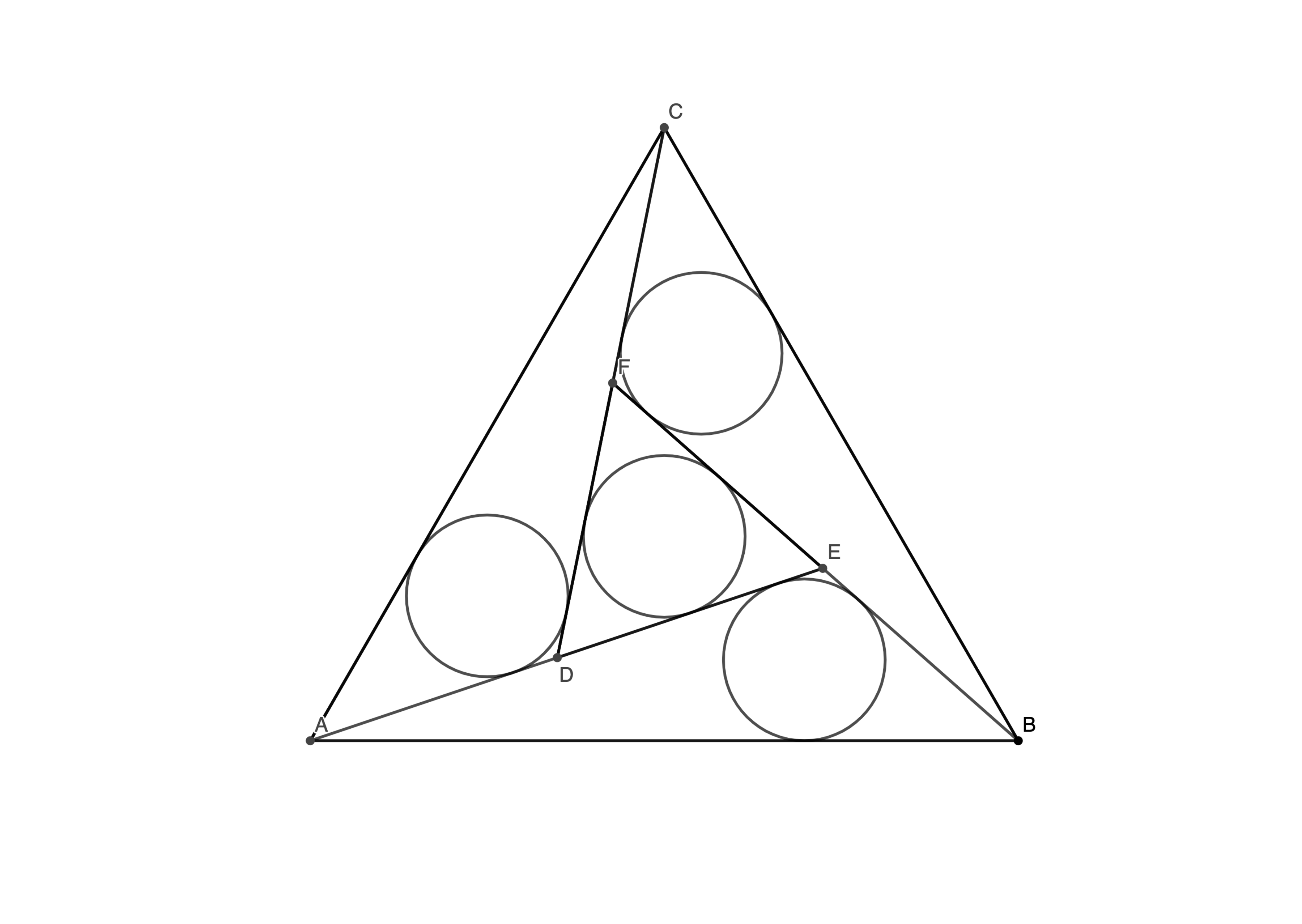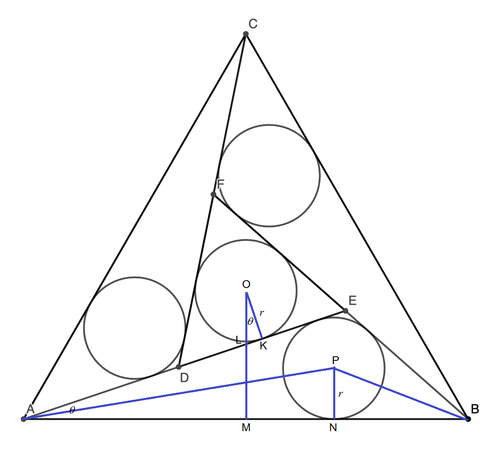Four More Incircles

△ A B C is the unit equilateral triangle. △ D E F is an equilateral triangle. The four incircles are congruent. What is their radius? Express it as c a − b , where b is square-free, and submit a + b + c
The answer is 58.
This section requires Javascript.
You are seeing this because something didn't load right. We suggest you, (a) try
refreshing the page, (b) enabling javascript if it is disabled on your browser and,
finally, (c)
loading the
non-javascript version of this page
. We're sorry about the hassle.
2 solutions
Nice - once again quite a different approach to mine. It's interesting how close the values of A D and D E are.
By the way, the answer can also be written as 8 7 − 3
Hi David, I always appreciate your solutions, which are amongst my favorites. Thanks so much. I have a question here : I do not understand the end of the first line. I would have expected √(k^2-k+1) instead of √(k^2-2k+1) as we have 2.k.(1/2).
Log in to reply
Thanks, it should have been k 2 − k + 1 . It was a typo that I kept copying and pasting in the rest of the problem. It should be fixed now.
Thanks ! It's always a pleasure to see how you solve this kind of problem almost without trigonometry !
Hi David, I fell really stupid but I cannot find out how to simplify the equation of ∆AEB incircle radius, to get r= 3/(2√3√(k^2-k+1) -√3/2. Would you be kind enough to give some intermediate results or tell "the trick" ? Thanks a lot.
Log in to reply
If you start by multiplying the expression by k 2 − k + 1 k 2 − k + 1 , then:
r = k 2 − k + 1 1 − k + k 2 − k + 1 k + 1 k 2 − k + 1 1 − k ⋅ k 2 − k + 1 k ⋅ 2 3 ⋅ k 2 − k + 1 k 2 − k + 1 = 1 + k 2 − k + 1 k 2 − k + 1 ( 1 − k ) k ⋅ 2 3
Then multiply the expression by 1 − k 2 − k + 1 1 − k 2 − k + 1 , so:
r = ( 1 + k 2 − k + 1 ) ( 1 − k 2 − k + 1 ) k 2 − k + 1 ( 1 − k ) k ⋅ 2 3 ⋅ ( 1 − k 2 − k + 1 ) = ( 1 − k ) k k 2 − k + 1 ( 1 − k ) k ⋅ 2 3 ⋅ ( 1 − k 2 − k + 1 )
Then simplifying:
r = ( 1 − k ) k k 2 − k + 1 ( 1 − k ) k ⋅ 2 3 ⋅ ( 1 − k 2 − k + 1 ) = k 2 − k + 1 1 ⋅ 2 3 ⋅ ( 1 − k 2 − k + 1 ) = 2 3 k 2 − k + 1 3 − 2 3 .
thank you so much ! I really do appreciate your help and how much I can learn from your elegant solutions ! Gerard.

Let the centers of the middle and the right circles be O and P respectively, O M and P N be perpendicular to A B , O K be perpendicular to A E , and O M and A E intersect at L . Let ∠ E A B = ∠ L O K = θ , then ∠ E B A = 6 0 ∘ − θ , and the radius of the four congruent circles be r .
Then we have:
A N + N B r cot 2 θ + r cot ( 3 0 ∘ − 2 θ ) t r + 1 − 3 t 3 + t ⋅ r ⟹ r = A B = 1 = 1 = 1 + t 2 t ( 1 − 3 t ) Let t = tan 2 θ
Note that O is also the centroid of △ A B C . Therefore O M = 6 3 . Then
O L + L M r sec θ + 2 1 tan θ 1 − t 2 1 + t 2 ⋅ r + 1 − t 2 t ⟹ r = O M = 6 3 = 6 3 = 6 ( 1 + t 2 ) 3 − 6 t − 3 t 2
Therefore
6 ( 1 + t 2 ) 3 − 6 t − 3 t 2 5 3 t 2 − 1 2 t + 3 ⟹ t = 1 + t 2 t ( 1 − 3 t ) = 0 = 5 3 6 − 2 1 = 5 2 3 − 7
Then r = 1 + t 2 t ( 1 − 3 t ) = 3 2 5 − 2 1 . Therefore a + b + c = 5 8 .
Extend C D to meet A B at G , A E to meet B C at H , B F to meet A C at I , and let k = A G = B H .
By the law of cosines on △ A B H , A H = B H 2 + A B 2 − 2 ⋅ B H ⋅ A B ⋅ cos ∠ A B H = k 2 + 1 − 2 ⋅ k ⋅ 2 1 = k 2 − k + 1 .
Since △ A G D ∼ △ B H E by AA similarity, A D = A G ⋅ A H A B = k ⋅ k 2 − k + 1 1 = k 2 − k + 1 k = E B .
Also, G D = A F ⋅ A H B H = k ⋅ k 2 − k + 1 k = k 2 − k + 1 k 2 = E H .
Then D E = A H − A D − E H = k 2 − k + 1 − k 2 − k + 1 k − k 2 − k + 1 k 2 = k 2 − k + 1 1 − 2 k .
And A E = A D + D E = k 2 − k + 1 k + k 2 − k + 1 1 − 2 k = k 2 − k + 1 1 − k .
As an incircle of equilateral △ D E F , r = 2 3 1 ⋅ D E = 2 3 1 ⋅ k 2 − k + 1 1 − 2 k = 2 3 k 2 − k + 1 1 − 2 k .
As an incircle of △ A E B , r = A E + E B + A B A E ⋅ E B ⋅ sin ∠ A E B = k 2 − k + 1 1 − k + k 2 − k + 1 k + 1 k 2 − k + 1 1 − k ⋅ k 2 − k + 1 k ⋅ 2 3 = 2 3 k 2 − k + 1 3 − 2 3 .
So r = 2 3 k 2 − k + 1 1 − 2 k = 2 3 k 2 − k + 1 3 − 2 3 , which solves to k = 1 0 1 7 − 3 2 1 and r = 3 2 5 − 2 1 .
Therefore, a = 5 , b = 2 1 , c = 3 2 , and a + b + c = 5 8 .